Expansion tank for water supply: selection, design, installation and connection
Autonomous water supply, independently supplying water to the points of analysis in a city apartment, has long ceased to be a curiosity. This is the norm of suburban life, which just needs to be properly designed, assembled and equipped with equipment capable of starting and stopping the system as you use the cranes.
The stable operation of an independent network will be ensured by an expansion tank for water supply. It protects against water shocks, significantly prolongs the working life of pumping equipment, guarantees regular filling of the system with water, eliminates the need to carry it in buckets.
We are pleased to introduce you to the features of the device and the principle of operation of the accumulator. We carefully described the rules for choosing a membrane tank, the specifics of installation and connection. We supplemented the information proposed for consideration with useful illustrations, diagrams, and video tutorials.
The content of the article:
Characteristics of closed expansion tanks
Hydraulic tank (or accumulator, expansion tank) - this is a metal hermetic container, which serves to maintain a stable pressure in the water supply system and create water reserves of different volumes.
At first glance, the choice and installation of this device should not cause difficulties - in any online store you can see many models that only slightly differ in shape and volume, but do not significantly differ in their functionality.
It's not like that at all. There are many nuances in the design of the expansion tank and the principle of its operation.
Features of the device and design
Different models of expansion tanks may have restrictions on the method of use - some are designed only for working with industrial water, others can be used for drinking water.
By design, hydraulic accumulators are distinguished:
- removable pear tanks;
- tanks with a fixed membrane;
- hydraulic tanks without a membrane.
On one side of the tank with a removable membrane (the tank with the lower connection is at the bottom) there is a special flange with a thread, to which the bulb is attached. On the reverse side there is a nipple for pumping or bleeding air, gas. It is designed to connect to a conventional car pump.
In a tank with a replaceable bulb, water is pumped into the membrane without touching a metal surface. The membrane is replaced by unscrewing the flange that the bolts hold. In large containers, to stabilize the filling, the rear wall of the membrane is additionally attached to the nipple.
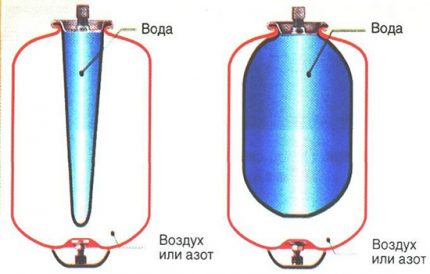
The internal space of the tank with a fixed membrane is divided into two compartments. In one is gas (air), in the other comes water. The inner surface of such a tank is coated with moisture resistant paint.
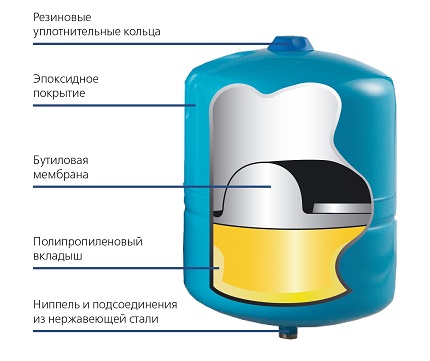
There are also hydraulic tanks without a membrane. In them, the compartments for water and air are not separated by anything. The principle of their action is also based on the mutual pressure of water and air, but with such an open interaction, two substances are mixed.
The advantage of such devices is the absence of a membrane or pear, which is a weak link in conventional accumulators.
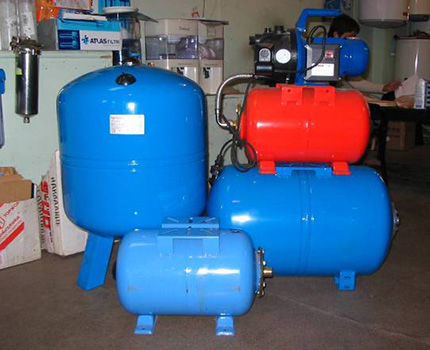
The diffusion of water and air makes servicing the tanks quite often. About once a season you have to pump air, which gradually mixes with water. A significant reduction in air volume, even at normal pressure in the tank, causes the pump to turn on frequently.

The principle of operation of the accumulator
Closed water tanks for water supply They work according to this scheme: the pump delivers water to the pear, gradually filling it, the membrane increases and air is compressed between the pear and the metal casing.
The more water enters the pear, the more it presses on the air, and that, in turn, tends to push it out of the container. As a result, the pressure in the tank rises, this leads to a shutdown of the pump.
For some time, when the system consumes water, compressed air maintains pressure. He pushes water into the plumbing. When its quantity in the membrane decreases so that the pressure drops to the lower limit, the relay is activated, again turning on the pump.
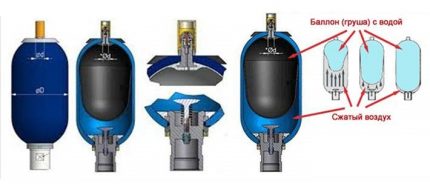
Classification by application
You should not confuse the tanks for water supply and for the heating system, so when choosing you need to find out their purpose. For a clear identification, manufacturers paint accumulators for heating in red, for water supply - in blue.
However, some do not adhere to this marking, so the following data can serve as a distinguishing feature of devices:
- for water supply, the maximum temperature for using the accumulator will be up to 70 ° C, the permissible pressure can reach 10 bar;
- devices designed for the heating system can withstand temperatures up to +120 ° C, the working pressure of the expansion tank often does not exceed 1.5 bar.
All the most important parameters are indicated on the decorative cap (nameplate), which closes the nipple.
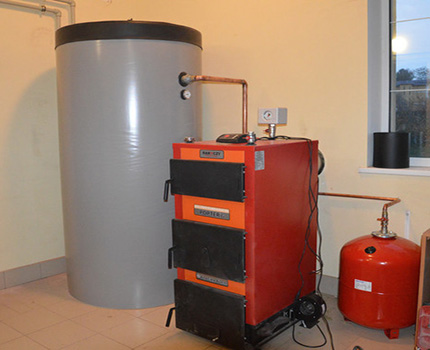
The list of functions that a hydraulic tank performs in an HV (cold water supply) system is much wider:
- Maintaining an even and constant pressure in the water supply. Due to air pressure, the pressure is maintained for some time even when the pump is turned off, until it drops to the set minimum and the pump switches back on. Thus, the pressure in the system is maintained even with the simultaneous use of several plumbing fixtures.
- Pump equipment wear protection. The water reserves contained in the tank allow for some time to use the water supply, not including the pump. This reduces the number of pump operations per unit time and prolongs its operation.
- Water hammer protection. A sharp jump in pressure in the water supply when the pump is turned on can reach 10 or more atmospheres, which negatively affects all elements of the system. The membrane tank takes the blow, equalizing the pressure.
- Creating water reserves. With a power outage, the water supply system will at least for a short time, but, nevertheless, give water for some more time.
To tie the water heater use expansion tanks that can withstand high temperatures.
Materials for hydropneumatic equipment
The expansion tank membrane is made of different materials that withstand a different temperature range during operation.
In accumulators used:
- Natural rubber rubber - NATURAL. The material can come into contact with drinking water; it is used to accumulate cold water. Over time, it may begin to leak water. It withstands temperatures from -10 and up to 50 ° C above zero.
- Synthetic butyl rubber - BUTYL.The most versatile, waterproof, used for water supply stations, suitable for drinking water. Operating temperatures can range from -10 to 100 ° C.
- Synthetic ethylene propylene rubber - EPDM. More permeable than the previous one, may come into contact with drinking water. The temperature range is from -10 to 100 ° C.
- SBR rubber is used only for industrial water. The temperature of use is the same as that of previous brands.
To organize cold water supply, it is necessary to choose tanks with a pear made of food rubber with improved elastic properties, which will better absorb hydraulic shocks and maintain a stable water pressure in the system.
The tank body is most often made of alloy steel, resistant to corrosion, coated on the outside with a paintwork. On sale you can also find stainless steel tanks, very durable, but at the same time expensive.
Calculating tank volume before choosing
Tanks with a capacity of 24 to 1000 liters are on sale. Which one to choose, prompt calculations, the result of which should be rounded up. When choosing a tank with a removable membrane, it should be remembered that the volume of water occupies 30% of the total capacity, that is, in a 100-liter tank, the water supply will be approximately 30 liters.

A feature of small tanks is that they often do not have a valve to bleed air from a rubber bulb. This may create inconvenience during operation. Large tanks have such a valve, and in addition to creating a larger supply of water, they better cope with maintaining a stable pressure in the system.
The calculation of the total volume of the hydraulic tank for closed water supply is calculated by the following formula:
Vt = K * Amax * ((1 + Pmax) * (1 + Pmin)) / (Pmax-Pmin) * (1 + Pmax),
Where:
- Vt is the total volume of the hydraulic tank;
- Amax - maximum possible water consumption per minute, liter;
- K - coefficient (see table), depending on the power of the pump;
- Pmax - relay settings during equipment shutdown, bar;
- Pmin - relay settings when starting up the equipment, bar;
- Pair. - pressure in the hydraulic tank (in its gas cavity), bar.
The coefficient K can be determined from the following table:

Some manufacturers also consider the tank volume differently:
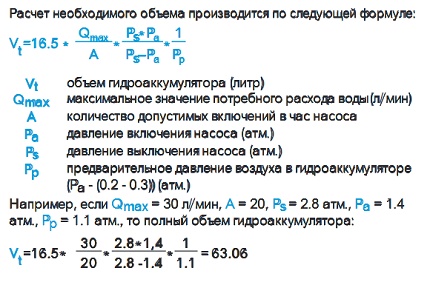
Horizontal and vertical orientation
The choice between a vertical and horizontal tank is in the features of the room. If the room is small or the volume of the tank is impressive, then in order not to take up much space, install a vertical tank.
The horizontal tank has a lower capacity, can be suspended on the wall, and also serve as a support for the installation of a surface pump.For its installation, special mounts are provided. Large tanks are made only in vertical design and are mounted on legs.
Summing up all of the above, it can be noted that the choice of a hydraulic accumulator has to be made between such distinctive properties:
- operating pressure;
- producing country;
- more or less volume;
- replaceable or not rubber membrane;
- membrane for industrial or drinking water;
- case material - stainless or enameled steel.
So that in the future there are no difficulties with the replacement of components, it is better to choose the most popular models of devices. Rubber pears for them are always on sale, if you need an urgent replacement, you do not have to wait long for delivery.
Connection schemes for hydraulic tanks
For hot water system installation of expansion tank carried out on the site of the circulation line, the suction line of the pump, closer to the water heater.
The tank is equipped with:
- pressure gauge, safety valve, air vent - safety group;
- shut-off valve with a device that prevents accidental blocking.
In a plumbing system where water-heating equipment is present, the device assumes the functions of an expansion tank.
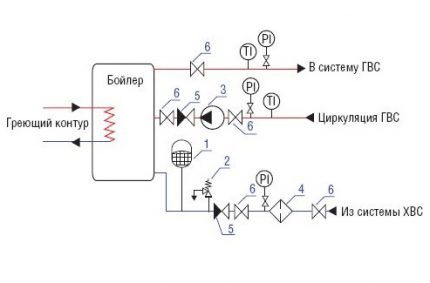
In the XB system, the main rule for installing a hydraulic accumulator - installation at the beginning of the piping, closer to the pump.
The connection diagram must include:
- check and shutoff valve;
- security group.
Connection schemes can be very different. The connected hydraulic tank normalizes the operation of the equipment, reducing the number of pump starts per unit time and thereby extending its service life.

In a circuit with a boost pumping station one of the pumps runs continuously. Such a system is installed for homes or buildings with high water consumption. The hydraulic tank here serves to neutralize pressure surges, and to store water, a capacity of as large a volume as possible is installed.
Installing the expansion tank
Before starting work, check the accumulator for damage. Installation of the device is carried out in a soundproofed room, at a plus temperature. In order to have access to the drain valve, shutoff valves, etc., the distance from the tank to the ceiling and walls is left at least 0.6 m.
In the room it is also necessary to provide for the possibility of filling the tank and draining the water. Fasteners and mounting location must withstand 100% full capacity.
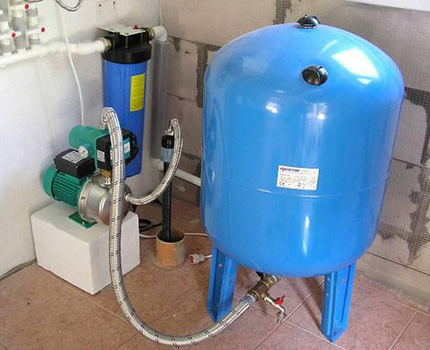
The accumulator must not be subjected to mechanical and statistical stress; it is undesirable to allow the impact of pipes and assemblies on it. The tank is screwed to the floor using rubber gaskets. At the entrance to the hydraulic tank, a check valve is installed, a drain valve.
These steps were required for the device accumulator harness, which was produced on the day surface. For further action, you need to move to the caisson.
After the final assembly of the system, it remains to conduct control tests and start the water supply circuit.
Features of the accumulator adjustment
Expansion tanks for water supply go on sale with the standard settings of the manufacturer - often the pressure in the air compartment is already set at 1.5 bar. The permissible pressure is always indicated on the label and the manufacturer does not recommend deviating from the set parameters, especially in the direction of its increase.
Before starting the adjustment, the system is disconnected from the mains and the shut-off valves are closed. The membrane tank is completely emptied by draining the water - an accurate indicator of pressure can be measured only with an empty water compartment.
Then take pressure readings using an accurate pressure gauge. To do this, remove the decorative cap from the spool and bring the device. If the pressure differs from the required, then it is brought into compliance, pumping or bleeding excess air.
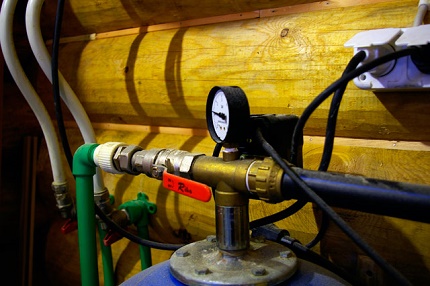
When adjusting the pressure in the gas compartment of the tank, the manufacturer fills it with an inert gas, for example, dried nitrogen.This prevents corrosion of the inner surface. Therefore, users are also advised to use technical nitrogen to increase pressure.
Setting the tank pressure in the water supply system
The pressure in the closed tank is always set slightly lower (by 10%) than the pressure level when starting the pump. By adjusting the pressure in the device, you can adjust the water pressure. The lower the pressure of the gas in the hydraulic tank (but not less than 1 bar), the more water it will contain.
The pressure in this case will become uneven - strong when the tank is full and weaker when it is empty. To ensure a strong and even flow of water, set the pressure in the chamber with air or gas within 1.5 bar.
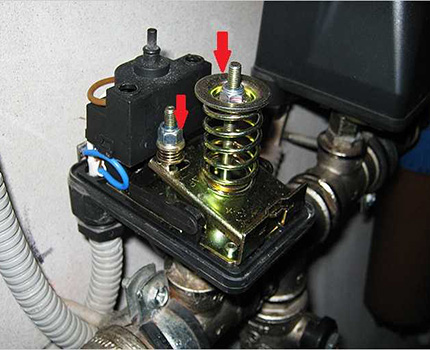
Adjusting the hydraulic tank in the tank
The expansion tank, which is used for hot water supply, should not initially contain water. The pressure in the device is set at an indicator that is 0.2 more than the upper threshold for shutting down the pump.
For example, if the relay is configured to turn off the equipment at a pressure of 4 bar, then the pressure in the gas compartment of the expansion tank should be set to 4.2 bar.
Installed in the piping of the water heater, the tank does not serve to maintain pressure. It is designed to compensate for expansion when water is heated. If you set the pressure in it to a lower value, then water will constantly be in the tank.
Service Tank Rules
A routine inspection of the expansion tank is to check the pressure in the gas compartment. It is also necessary to inspect the valves, valves, air vent, check the operation of the pressure gauge and water pressure switch. To verify the integrity of the tank conduct an external inspection.
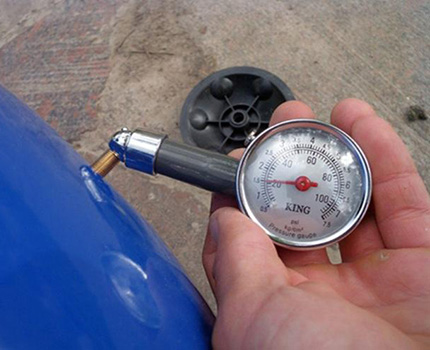
Despite the simplicity of the device, expansion tanks for water supply are still not eternal and can break. Typical causes are rupture of the membrane or loss of air through the nipple. Signs of breakdowns can be determined by the frequent operation of the pump, the appearance of noise in the water supply system. Understanding the operating principle of the accumulator is the first step towards proper maintenance and troubleshooting.
Installation of an open tank
An open type device is used less and less, since it requires constant user intervention in its work. An open expansion tank is an unpressurized container that serves to form water pressure, water storage, and also serves as an expansion chamber.
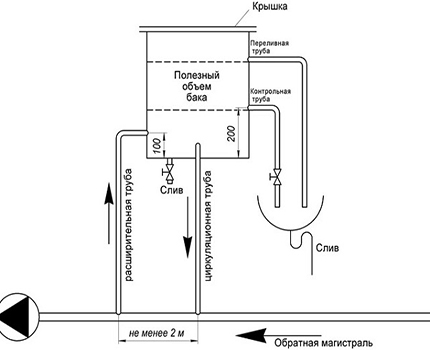
The tank is installed above the highest sanitary point, for example, in the attic, water flows into the system by gravity. Each meter that the device rises increases the pressure in the water supply by 0.1 atmospheres.
To automate the process of providing water, the tank is equipped with a float switch and an automatic relay is installed, which will turn the pump on and off.
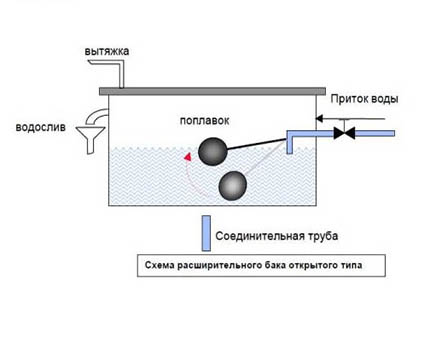
This way of organizing water supply requires regular user monitoring, otherwise the water at freezing temperatures may freeze (if the room is not heated). The liquid will evaporate, so you have to constantly add it.
In addition, such a container is bulky and not aesthetically pleasing, for it you must definitely have an attic in the house.But the main drawback of the device is that the tank is not adapted to work in conditions of high water pressure in the system.
Conclusions and useful video on the topic
Clip # 1. All about expansion tanks - classification, purpose, adjustment and symptoms of malfunctions:
Clip # 2. Improper operation of the pumping station is often associated with accumulator malfunctions:
Clip # 3. Nuances of choosing hydraulic tanks for water supply:
Even at the planning and development stage of the water supply system, it is necessary to think over all fundamentally important points and calculate all the parameters. If you are not sure of the infallibility of your calculations and the correct choice of a hydraulic tank for water supply, it is better to contact specialists.
Most companies selling professional equipment provide advice or even carry out calculations for free. This will help to avoid mistakes and waste.
We are waiting for your comments with stories about our own experience in using an expansion tank, with questions that arose during the familiarization with the information provided. We are interested in your comments and possible suggestions. You can comment on the material in the block below.

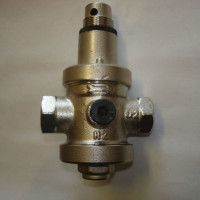 Water pressure reducer in the water supply system: purpose, device, regulation rules
Water pressure reducer in the water supply system: purpose, device, regulation rules 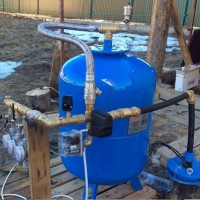 Hydraulic accumulators for water supply: operating principle, types, how to choose the right one
Hydraulic accumulators for water supply: operating principle, types, how to choose the right one 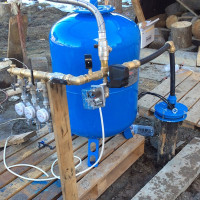 Do-it-yourself hydraulic accumulator: device, principle of operation, installation features
Do-it-yourself hydraulic accumulator: device, principle of operation, installation features  Water hammer in the water supply and heating system: reasons + preventive measures
Water hammer in the water supply and heating system: reasons + preventive measures 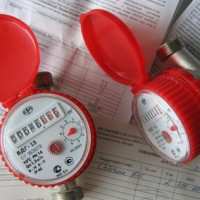 Water supply and sanitation rules: balance calculation + norms of water supply and consumption
Water supply and sanitation rules: balance calculation + norms of water supply and consumption  Overview of protection against water leaks “Aquastorozh”: device, advantages and disadvantages, installation rules
Overview of protection against water leaks “Aquastorozh”: device, advantages and disadvantages, installation rules  How much does it cost to connect gas to a private house: the price of organizing gas supply
How much does it cost to connect gas to a private house: the price of organizing gas supply  The best washing machines with dryer: model rating and customer tips
The best washing machines with dryer: model rating and customer tips  What is the color temperature of light and the nuances of choosing the temperature of the lamps to suit your needs
What is the color temperature of light and the nuances of choosing the temperature of the lamps to suit your needs  Replacement of a geyser in an apartment: replacement paperwork + basic norms and requirements
Replacement of a geyser in an apartment: replacement paperwork + basic norms and requirements
Accessible information is presented, with all the subtleties and features. I did not think that the tanks for water supply and for the heating system are so different. I did not suspect that they should be used strictly for their intended purpose, not confusing one with the other. They chewed everything, even using formulas. I thought that it would be easier to install a tank, but it is better to turn to plumbers.
The article states: “For a hot water system, an expansion tank is installed in the section of the circulation line, the suction line of the pump, closer to the water heater”, and in the diagram below the tank is connected to the cold water line. Is this not a dock or am I not understanding something? Can you explain?
When I installed the DHW system, the installers said that there are also membrane-free hydraulic accumulators. They are cheaper and, in their opinion, better, because there is no such element as a separating membrane. But I think that if suddenly water is lost from the accumulator, then all damping gas will also leave. I understand correctly? Could you please explain why the membraneless accumulators are better?
Hello. They have a different working principle:
1. The principle of operation of the station with a hydraulic accumulator. Water is supplied through a supply hose, most often equipped with a coarse filter and a non-return valve to prevent the outflow of water, from the source to the accumulator. When the membrane is filled, in combination with the air pressure in the tank, a signal is sent to the pressure switch, respectively, the pump turns off. When the pressure drops to a certain point as a result of the station’s water supply, the relay receives a signal and switches the pump back on.
2. The principle of operation without a hydraulic accumulator is even simpler. The faucet opens, the pump automatically turns on, and water begins to pump. The valve closes, the pump turns off.
For water supply systems, where there are few users of water - 1-2 people, option 2 is quite suitable, because such stations are more compact and the water in the pear does not stagnate. However, there is also no water supply that remains in the accumulator during a power outage and if a family of a large number of people uses it, that is, water is consumed in a larger volume, the pump crashes faster due to more intensive work.